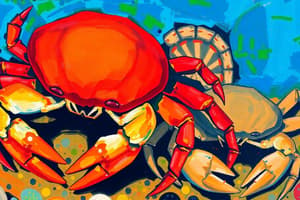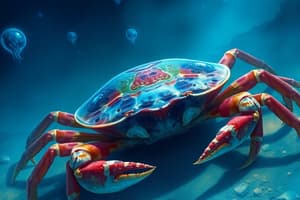Podcast
Questions and Answers
What is the main reason horseshoe crabs are referred to as 'living fossils'?
What is the main reason horseshoe crabs are referred to as 'living fossils'?
- Their unchanged body plan and behavior over millions of years. (correct)
- Their role as predators in their ecosystem.
- Their ability to survive in freshwater environments.
- Their genetic similarity to modern crabs.
Which component of horseshoe crab blood gives it a blue color?
Which component of horseshoe crab blood gives it a blue color?
- Heme
- Hemocyanin (correct)
- Chlorophyll
- Hemoglobin
What is limulus amebocyte lysate primarily used for in the medical field?
What is limulus amebocyte lysate primarily used for in the medical field?
- To improve blood clotting in humans.
- To test the sterility of vaccines. (correct)
- To enhance the blue color of blood.
- To treat infections in humans.
How many species of horseshoe crab are known to exist?
How many species of horseshoe crab are known to exist?
What characteristic distinguishes horseshoe crabs from true crabs?
What characteristic distinguishes horseshoe crabs from true crabs?
What is the primary purpose of hemocyanin in horseshoe crab blood?
What is the primary purpose of hemocyanin in horseshoe crab blood?
Where are horseshoe crabs typically found?
Where are horseshoe crabs typically found?
What allows horseshoe crab blood to combat infections effectively?
What allows horseshoe crab blood to combat infections effectively?
What is the primary reason for the harvesting of horseshoe crabs?
What is the primary reason for the harvesting of horseshoe crabs?
What unique characteristic does horseshoe crab blood have compared to human blood?
What unique characteristic does horseshoe crab blood have compared to human blood?
What is the primary method used for harvesting horseshoe crabs during their mating season?
What is the primary method used for harvesting horseshoe crabs during their mating season?
What was developed in the 1960s to test for the presence of endotoxins?
What was developed in the 1960s to test for the presence of endotoxins?
What impact does harvesting horseshoe crabs have on the Red Knot population?
What impact does harvesting horseshoe crabs have on the Red Knot population?
What is the typical mortality rate for horseshoe crabs after they are bled?
What is the typical mortality rate for horseshoe crabs after they are bled?
Why have attempts been made to create synthetic alternatives to horseshoe crab blood?
Why have attempts been made to create synthetic alternatives to horseshoe crab blood?
Flashcards are hidden until you start studying
Study Notes
Horseshoe Crabs
- Horseshoe crabs are ancient, predating dinosaurs.
- They have a body plan that has not changed in 445 million years.
- They have a thick exoskeleton protecting their soft body parts.
- They have blue blood with antibacterial qualities.
- They are more closely related to arachnids than crabs.
- There are four species:
- Tachypleus gigas (South Asia)
- Tachypleus tridentatus (South Asia)
- Carcinoscorpius rotundicauda (South Asia)
- Limulus polyphemus (North & South America)
Horseshoe Crab Blood
- Horseshoe crab blood is blue due to the oxygen-binding agent hemocyanin, which is rich in copper.
- Human blood is red due to the oxygen-binding agent hemoglobin, which contains iron.
- Horseshoe crab blood contains Limulus Amebocyte Lysate (LAL), which is an effective clotting agent used to test the sterility of vaccines.
Medical Applications
- The LAL test, developed in the 1960s, detects endotoxins in vaccines using horseshoe crab blood.
- The LAL test was approved in the 1970s and is mandatory for all vaccines.
- No synthetic substitute for LAL has been found.
Harvesting Horseshoe Crabs
- Methods:
- Dredging: Using a net dragged along the ocean floor, but this captures non-target species.
- Hand-collection: Collecting them by hand during mating season, where they congregate on beaches to spawn.
- Protocol:
- Collect horseshoe crabs by dredging or hand.
- Transport them to a lab for bleeding.
- Collect 30% of their blue blood in sterile containers.
- Either release the bled horseshoe crabs back to their environment, or bleed them fully and sell their bodies for bait.
Costs of Harvesting
- A quart of horseshoe crab blood sells for $15,000 or more due to the lack of synthetic alternatives.
- The FDA regulates horseshoe crab harvesting to ensure sustainability.
- A 10-15% mortality rate exists among bled horseshoe crabs, resulting in an estimated 25,000 deaths per year.
- The decline in horseshoe crab populations impacts the Red Knot bird, which relies on their eggs for food during migration.
Studying That Suits You
Use AI to generate personalized quizzes and flashcards to suit your learning preferences.




